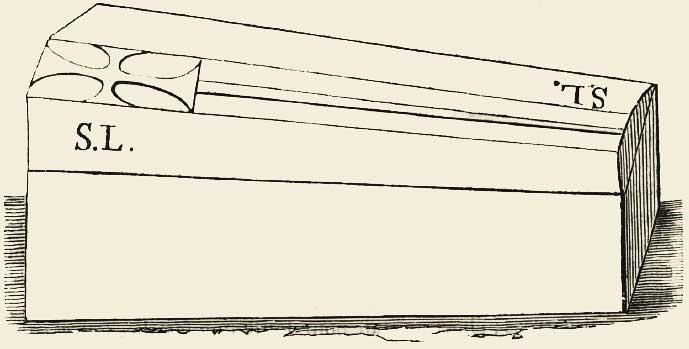The tomb of Saint-Lubin, Bishop of Chartres (544 to 556)
in Revue Archéologique, 15th Year, No. 1 (April to September 1858), pp. 35-39
by F. Jean Mabillon and Doublet de Boisthibault
François Jules Doublet de Boisthibault (1800 – 1862) was a lawyer at the Royal Court of Paris, attached to the bar of Chartres, journalist, writer, historian and archaeologist, and curator of the Chartres library. He was a contributor to the Revue archéologique.
His texts reflect the knowledge of the 19th century and the freedom of expression enjoyed by researchers at that time.

During the demolition of the chapel of Saint-Serge and Saint-Bacche (1) in Chartres, three tombs were discovered, two of which had three crosses pattées. This discovery gave rise to a correspondence in which you will find the names of Léonor d’Estampes, bishop of Chartres; of the abbot Chastelain, canon of Paris; of Father Esterlin of Sainte-Geneviève, and of the famous Benedictine D. Mabillon. The analysis of these letters is the basis and the interest of this notice. The tombs touched each other; they were of soft stone, and, nevertheless, rather hard; the feet approached very closely the foundations of the traffic circle of the chapel, and the head under the altar (2). The tomb of which we are going to speak was found on October 18, 1703, under the ruined altar of one of the chapels of Saint-Serge; it was larger, better heard and more magnificent than the others. Its dimensions will make one judge:
Length …… 2m,111
Width of the side of the head …… 1m,56
Width of the opposite side …… 0m,326
Height …… 1m,56
(1) This chapel had two entrances: one on the side of the episcopal palace, the other, the principal one, on the side of the cloister.
(2) Letter from Léonor d’Estampes, bishop of Chartres.
The rebated lid was 2m,274 long, 0m,326 thick.
This tomb contained a body minus the head. No inscription, but in its place a cross with a handle, such as the drawing represents.
As for the difference noticed in the size of these tombs, the abbot Chastelain explained it as follows (1):
“The same thing is seen in Rome in the underground cemeteries. Having gone down into the one whose entrance is near Saint-Laurent hors les murs (2), the regular canons of the place, who had made me light torches, pointed out to me that the cavities which are like drawers one on top of the other on each side of the long vaulted alleys of this cemetery, are the tombs of the common people, but that those of the people of distinction are in the vaulted rooms whose doors I saw from space to space, on the right and on the left. I entered seven of these chambers; they are square; each was for a whole family. The drawer-like cavities hold the space from one corner to the other, one on top of the other, and this is the length of an ordinary body. But, the side where the door is only leaves a space of a third more, and it is on this side where the tombs of those who died in childhood are, as in Saint-Serge de Chartres, a third or so shorter than the others.”
(1) Letter of May 29, 1703.
(2) This basilica belongs to the century of Constantine. Its pulpits are called ambos. The frescoes of its portico are remarkable.
This cross, which was not found on the other two tombs, presented something singular; one sought to explain the presence of this cross. Did it designate a bishop, a patriarch, a metropolitan?
On October 29, D. Mabillon answered:
“The new discovery that you have just made is hardly less curious. Would it not be the tomb of Frotboldus, a bishop who was killed by the Normans in 858? See the IInd volume of our Analects, p. 550, etc. :
“The piece of leather (1) worked with hot iron and formed into strips may be the strip of the front of the chasuble with which he would have been buried. Perhaps this bishop, that is, Frotboldus, whose head is said to be cruentis gladiis mactatus est, was cut off, and that this is the reason why his head is not found in this tomb. It gives no other indication, except that it was a Christian who was buried there.”
It was pointed out to Father Mabillon (2), as for Frotbold, that, according to the Annals of Saint Bertin, he was drowned in the river Eure while escaping from Chartres, which was besieged by the Normans (3). It was added that this tomb could be taken for that of Saint Lubin (4). The body was deprived of its head, which was preserved in one of the treasures of the church of Chartres (5); and Chalétric was buried near Saint Lubin, his predecessor. Since these two tombs were found together, it was to be assumed, once the one of Saint Chalétric was recognized, that the other was that of Saint Lubin.
(1) It was a piece of brown leather two or three fingers wide, carefully worked and formed in strips with a hot iron, one of three raised fillets, another pierced with an infinite number of small holes sown in order, of which the middle two were raised in the form of a chagrin; the next was of three fillets and the one after that of these small holes and so on. Was it a sandal or another ecclesiastical ornament? (Letter to Fr. Mabillon).
(2) Letter of November 8.
(3) Pridie idus junii an. incarnationis dominicæ octingentesimo quinquagesimo octavo indictione sexta a paganis sequanensibus facta est magna cœdes Carnoti in qua interempti sunt Frotboldus episcopus, Stephanus presbiter (Necrol.).
(4) In the cloister, near the church, there was a chapel called St. Lubin.
(5) It was enclosed in a gilt bust, 0.682 meters high, covered in gems.
To be continued…